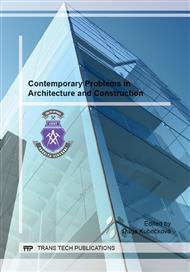[1]
Mahendran M., Keerthan P., Experimental studies of the shear behavior and strength of LiteSteel beams with stiffened web openings, Engineering Structures 49 (2013) 840–854.
DOI: 10.1016/j.engstruct.2012.12.007
Google Scholar
[2]
Adamus J., Lacki P., Więckowski W., Numerical simulation of the fine blanking process of sheet titanium, Archives of Metallurgy and Materials 56, Issue 2 (2011), 431-438.
DOI: 10.2478/v10172-011-0046-4
Google Scholar
[3]
Wieckowski W., Lacki P., Adamus J., Modelling of fine blanking process of the aluminium sheets, 14th International Conference on Sheet Metal, SheMet 2011, Vol. 473, 290-297.
DOI: 10.4028/www.scientific.net/kem.473.290
Google Scholar
[4]
Adamus J., The influence of cutting methods on the cut-surface quality of titanium sheets, Key Engineering Materials (2007) Vol. 344, 185-192.
DOI: 10.4028/www.scientific.net/kem.344.185
Google Scholar
[5]
Ellobody E., Nonlinear analysis of cellular steel beams under combined buckling modes, Thin-Walled Structures 52 (2012) 66–79.
DOI: 10.1016/j.tws.2011.12.009
Google Scholar
[6]
Liu T.C.H., Chung K.F., Steel beams with large web openings of various shapes and sizes: finite element investigation, Journal of Constructional Steel Research 59 (2003) 1159–1176.
DOI: 10.1016/s0143-974x(03)00030-0
Google Scholar
[7]
Erdal F., Doğan E., Saka M.P., Optimum design of cellular beams using harmony search and particle swarm optimizers, Journal of Constructional Steel Research 67 (2011) 237–247.
DOI: 10.1016/j.jcsr.2010.07.014
Google Scholar
[8]
Amancio-Filho S.T., Sheikhi S., dos Santos J.F., Bolfarini C., Preliminary study on the microstructure and mechanical properties of dissimilar friction stir welds in aircraft aluminium alloys 2024-T351 and 6056-T4, Journal of materials processing technology 206 (2008).
DOI: 10.1016/j.jmatprotec.2007.12.008
Google Scholar
[9]
Lacki P., Kucharczyk Z., Śliwa R. E., Gałczyński T., Influence of selected parameters of friction stir welding process on the temperture, Rudy Metale R57 (2012) No. 8 524-531.
Google Scholar
[10]
Gibson B.T., Lammlein D.H., Prater T.J., Longhurst W.R., Cox C.D., Ballun M.C., Dharmaraj K.J., Cook G.E., Strauss A.M., Friction stir welding: Process, automation, and control, Journal of Manufacturing Processes (2013).
DOI: 10.1016/j.jmapro.2013.04.002
Google Scholar
[11]
Mishra R.S., Ma Z.Y., Friction stir welding and processing, Materials Science and Engineering 50 (2005) 1–78.
Google Scholar
[12]
David S. A., Feng Z., Friction Stir Welding of Advanced Materials: Challenges, Metals and Ceramics Division Oak Ridge, TN., Austria, (2004).
Google Scholar
[13]
Lacki P., Derlatka A., The application of FSW technology in aluminium structures, Metal forming, Vol. 24 (2013) 205-218.
Google Scholar
[14]
Kudła K., Wojsyk K., Welding energy and heat input in welding process, Przegląd spawalnictwa 12 (2010) 21-25.
Google Scholar
[15]
Kudła K., Wojsyk K., Ocena ilości ciepła wprowadzanego w procesach spawania łukowego elektrodą topliwą w osłonie gazów ochronnych, Biuletyn Instytutu Spawalnictwa w Gliwicach 5 (2010) 121-126.
Google Scholar
[16]
Lacki P., Wojsyk K, Kudła K., Śliwa R. E, Friction welding of the bars made of aluminium and titanium alloys, ECCOMAS 2012 - European Congress on Computational Methods in Applied Sciences and Engineering, e-Book Full Papers (2012) 5029-5041.
Google Scholar
[17]
Lacki P., Kucharczyk Z., Śliwa R. E, Gałaczyński T., Effect of tool shape on temperature field in friction stir spot welding, Archives of metallurgy and materials Vol. 58 (2013) 595-599.
DOI: 10.2478/amm-2013-0043
Google Scholar
[18]
Kudła K., Wojsyk K., Adamus K.: Właściwości złączy zgrzewanych punktowo metodą zgrzewania tarciowego z przemieszaniem FSSW i RFSSW. Metal forming Vol. XXIV No. 3 (2013) 193-203.
Google Scholar


